Fireplace device: types and principle of operation
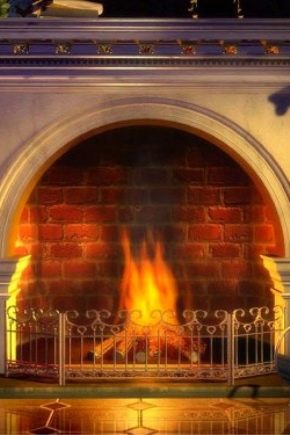
Nowadays, fireplaces are becoming more and more popular. Classic options are installed, as a rule, only as a decorative element or an additional source of heating. The fact is that the device does not provide for the accumulation of heat; the room cools down quickly after the flame goes out.

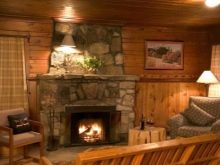
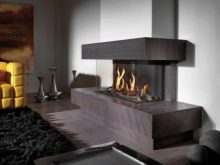
The classic design serves as an additional source of room ventilation, which is not a plus in the harsh Russian climate. To avoid negative factors and create a soulful atmosphere, the developers have found affordable ways to preserve the beautiful tradition of heating a private house.
Features and types of construction
A wood-burning and coal-burning fireplace is one of the most common options in country houses. It is built from all kinds of materials - brick, concrete, sheet steel or other metal. A distinctive feature of all classic varieties is a straight chimney connected to a wide open space of the firebox.

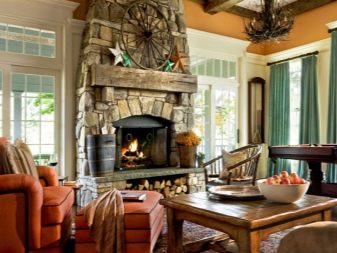
Let's consider the main elements of the fireplace.
- Under - the lower strictly horizontal part of the structure, intended for the location of firewood. It can be deaf or with grates - holes.
- The firebox is a space for fire. The back wall is tilted to increase heat reflection into the room. In some classic versions, the side walls are also laid out.
- Smoke chamber - connects the firebox and the chimney, it is necessary to collect gases during strong smoke formation.
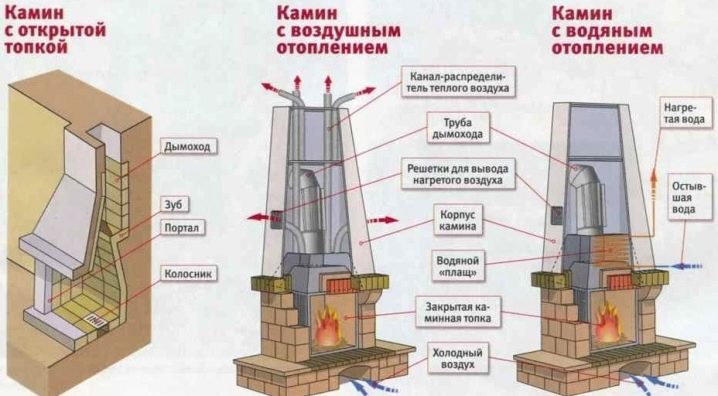
- Smoke tooth or gas sill is a protrusion in the chamber that prevents backflow and ensures collection of condensate during firing up. The width of the element is the same as that of the camera.
- Chimney or chimney - serves to remove smoke. It can be square, round or rectangular. To adjust the thrust along the length of the structure, one or two valves are installed. They also impede natural ventilation when the fireplace is idle.
- The portal is the entrance frame of the firebox, serves as a limitation of the working area and a decorative element at the same time.

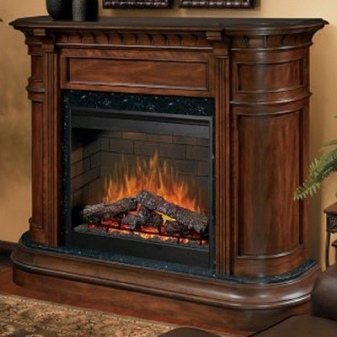
Portal shapes can be different depending on the design style. U-shaped are inherent in English, Old Germanic, French styles, as well as minimalism and hi-tech. Country and modern art nouveau gravitate towards the "D" form. Metal allows you to create any configuration from a classic barrel to an intricate bird's nest or pear.
Cladding with natural stone, expensive types of wood, bricks, refractory plasters or tiles is used as a decoration. Forging or inlay looks great in expensive models of portals.


When choosing a fireplace for your home, you should take a closer look not only at the external design, but also at the place of its future location.
The type of construction is distinguished:
- built-in (closed) - they are arranged in the recesses of the walls or specially designed niches, the portal does not protrude beyond the line of the wall;
- half-open - partially protrude beyond the line of interior partitions;
- in the openings - corner options that can heat two rooms at once;
- wall-mounted - based on the name, they do not have a fulcrum under them, they are fixed on the wall or in the corner; usually small in volume;
- open.
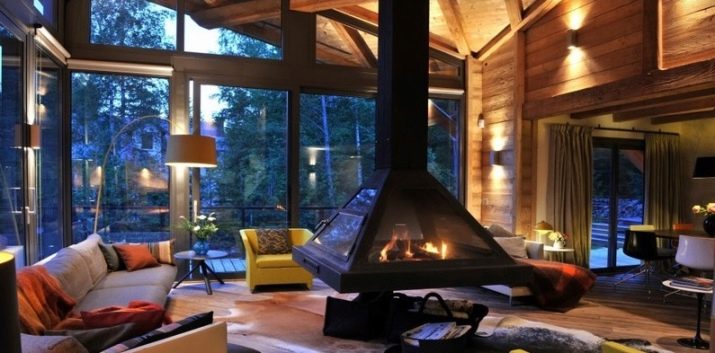
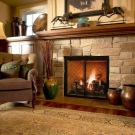
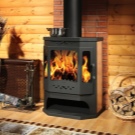

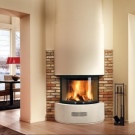
Heat exchange
The principle of the fireplace is simple.The spread of heat in the room is carried out by the radiation energy from the fire and heating elements of the structure, which creates a slight movement of convection currents.
The impressive size of the chimney prevents the ingress of carbon dioxide into the room. The thrust is quite large, the required air velocity in the pipe is not less than 0.25 m / s.
The heat transfer of a classic fireplace is small - 20%, the rest comes out through the chimney.
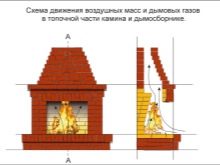
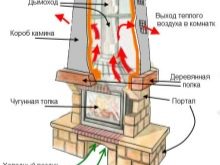
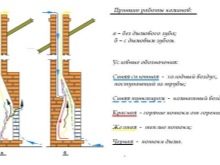
There are several ways to increase the intensity of heat transfer:
- additional installation of side and rear walls of the structure;
- using metal as a lining for the walls of the firebox;
- equipment of the portal with a fireproof door, which completely covers the firebox (for metal products).
On sale you can find a wide variety of ready-made fire-resistant steel inserts. Professionals recommend giving preference to cast iron models: they are insured against deformation at high temperatures. But the main guideline for finished products is the correspondence of the characteristics of the model specified in the data sheet to the conditions of your room.
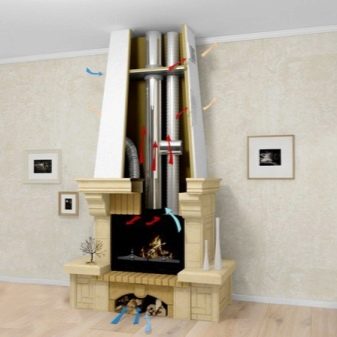
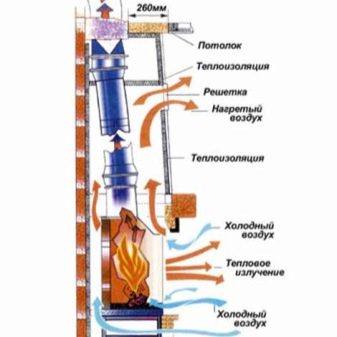
Doors for metal fireboxes can be of various sizes and opening methods: upward, to one side. Restricting the flow of air in closed structures ensures not burning, but smoldering wood. The walls of the fireplace heat up and supply the room with heat. In such conditions, one bookmark of firewood is enough for the whole night.
The limitation of the open fire zone also affects the intensity of heating.
- two portal walls on the sides - enough power only for small rooms; to increase radiation, the side inner walls are shaped like a trapezoid with an extension towards the room.
- one side panel - such shapes contribute to increased air extraction from the room into the chimney, but the heat radiation spreads over a larger radius;
- flames open on all sides (Alpine or Swiss fireplaces) - ineffective for heating, although heat can be radiated in all directions.
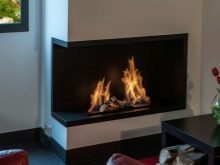
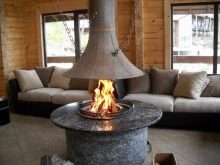

Manufacturers of combustible biomaterials and pellets have also achieved a slowdown in the combustion process due to the peculiarities of the composition of the feedstock. They assure that their products increase the heating efficiency to the level of a Dutch oven or a Swedish stove.
It is also possible to increase heat transfer by increasing the area of the chimney: its surface heats up and can also serve as a heat source. For this, a recuperator is used - a ribbed insert in the chimney made of stainless steel. Its length ranges from 0.5 to 1 m. The cross-section of such a pipe must match the diameter of the chimney.
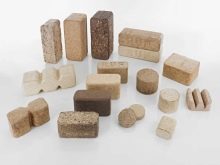
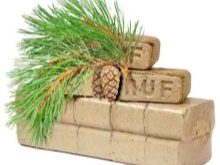
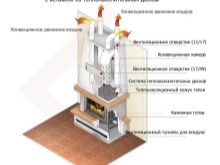
Forced air exchange
Knowledge of the peculiarities of air movement in the system will help to use the flows to increase traction and additional heating of a private house. And also make the control of the intensity of heat supply automatic.
Natural air exchange is used, as a rule, when the fireplace is heated from time to time. Artificial is more effective when the hearth operates frequently or when the chimney system has a complex configuration. No matter how they reduce the number and length of horizontal pipe elements, they manage to play their negative role.
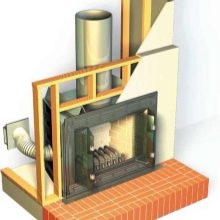
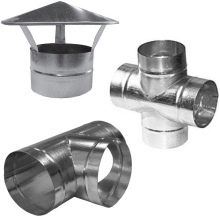

The essence of the improvement is that the inflow of external air increases the thrust, and ensures its constant value. It also removes air locks that form when there is a large temperature difference inside and outside the building. There are no problems with kindling during the onset of cold weather in such a system.
To achieve this goal, one, and in some cases two or three fans is installed. They are built in at the air inlet to the firebox and on the path of the flow in the main channel away from the premises where people live. The best place is at the level of the attic or utility room. The gravitational system does not overlap, and the amount of air entering the system immediately increases by 30-50%, the throughput - up to 600 m3 / h.
It is possible to automate the system with connection to a temperature sensor in the fireplace. It becomes possible to control the traction with the remote control without getting up from the sofa.
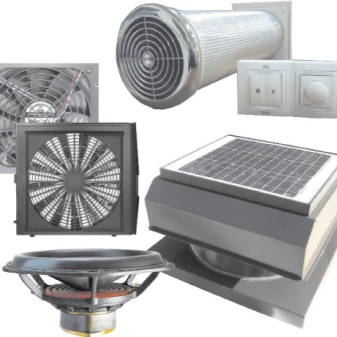

Special equipment is required - high-temperature centrifugal fans. The characteristics are selected based on the volume of air they can supply and the pressure they apply to the system. The latter indicator is determined by the pressure loss in certain sections of the pipe.
To equip you need:
- air diffusers with a protective grill;
- heat-insulated air ducts made of galvanized stainless steel, adapters;
- recuperator - the throughput of air heating is calculated with a margin for folds;
- fans;
- coarse filters;
- throttle valves - needed to adjust the volume of incoming air.
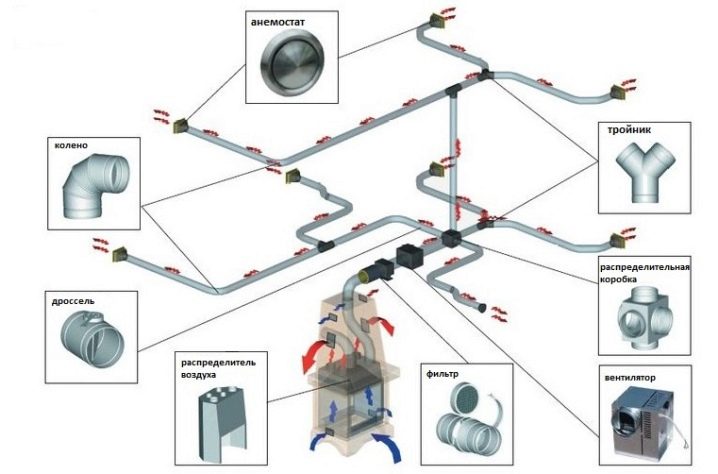
In some cases, the air exchange system is equipped with an air heater, which is installed above the position of the recuperator. This allows you to quickly heat a large amount of incoming air and not reduce the degree of heat.
It is possible to automate the entire system with connection to a temperature sensor in the fireplace. In this case, it is easy to control the traction from the shield or the remote control without getting up from the sofa.
Efficiency is increased if the pipes have an absolutely smooth inner surface and do not have a large number of horizontal and inclined joints. Ideal conditions are achieved with a circular cross-section of the chimney parts.
With all the advantages of this solution, there are also disadvantages:
- increased consumption of energy carriers - solid fuel and electricity;
- fan noise - special mufflers are required to suppress;

- noise in pipes - occurs when the chimney is small, incorrect selection to the power of the furnace;
- noise and vibration indicate defects during installation, are eliminated by repair.
Power
To find out the values, there is a standard NF D 35376, which was developed in France. It allows you to find out the nominal power of the furnace in kW - the amount of heat that the model can provide in three hours of operation.
It is very important not to confuse it with the maximum values that are usually indicated in the characteristics for finished products. The fireplace reaches its maximum heating in 45 minutes after kindling, and these power values are 2-3 times higher than its real capabilities.
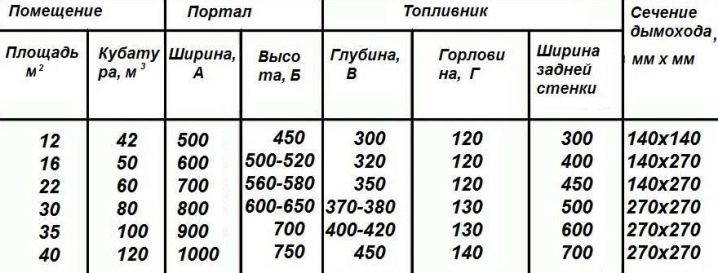
Power is determined by the volume of the firebox: the larger its space, the stronger the nominal capabilities. The distribution in the amount of energy for fireplaces ranges from 10 to 50 kW on average.
For a reference point:
- for a cozy room of 10 m² with a ceiling height of 2.5 m, 1 kW is required for heating;
- birch firewood (dry, moisture up to 14%) - 1 kg when burned out gives 4 kW of energy.
Experts recommend choosing the power of metal structures by 10-15% more than indicated in the passport of the finished product, because laboratory indicators, as a rule, do not coincide with real ones under normal operating conditions.
The high power of the firebox allows you to heat the room faster with the door closed and keep the temperature in the smoldering mode for a longer time. It is not advised to use the maximum resource of the firebox for a long period of time, this will lead to its rapid wear.

The ability to supply the room with heat is provided not least by the dimensions of the model.
Dimensions (edit)
The scale of the object depends on the purpose of the installation. For exclusively decorative tasks, the values will be in direct proportion to the values of other elements of the interior of a country house. Heating requires a different approach. It is necessary to calculate the power of the fireplace and relate it to the volume of the room.
table
Basic values for a classic semi-open fireplace.
In order to maintain a harmonious combination of the main structural elements, the following factors must be taken into account:
- The height of the rectangular opening of the firebox is 2/3 in large fireplaces, and 3/4 of its width in small ones.

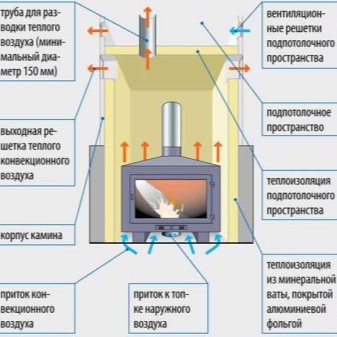
- The depth of the firebox should be in the range from 1/2 to 2/3 of the height of the portal opening.
- The opening area is always in accordance with the area of the room - from 1/45 to 1/65.
- The height of the pipe increases the draft, it is much longer in terms of its values than for a conventional furnace. The minimum dimensions for the chimney chimney from the base - dry hearth or grate - should not be less than 5 m.
- The chimney diameter is 8 to 15 times smaller than the area of the room. The lower the height of its structure, the larger the section for an equal area of the room.
For example:
- for a bedroom of 15 m² with a chimney length of 5 m, the cross-section will be 250x250 mm;
- for a spacious living room of 70 m² with a pipe length of up to 10 m - 300x300 mm;
- for a living room of 70 m² with a pipe length of 5 m - 350x350 mm.
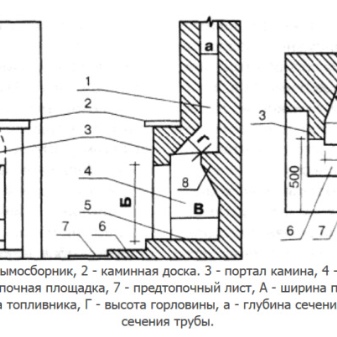
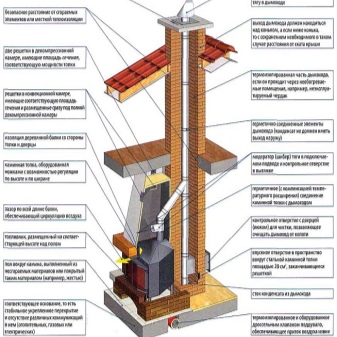
In addition to straight pipes, which are installed during the construction of a house, inclined pipes are used. They can be mounted to existing chimneys or ventilation wells, hoods. This option is suitable for installation under all necessary conditions in the already living room of the cottage.
DIY fireplace
The construction of such structures requires a lot of knowledge and skills. You can build a false hearth on your own, it will hold onto the floor slabs without any problems. For a real heated structure, it must be approached with all seriousness. Design should begin at the planning stage of the house.
Necessary steps:
- choose a model and calculate its power;
- calculate the foundation and combine it with the floor overlap;
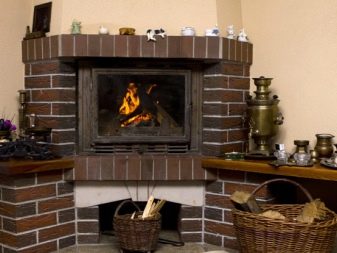

- plan and display the necessary changes in the roof structure on the diagram;
- determine the materials and their quantity for all types of work, including the facing of the fireplace;
- create sketches and drawings;
- provide for the safety of use, pay special attention to fire-fighting measures.
Before turning to experts for advice, you need to present your future fireplace in all its glory. They start with a sketch, and then move on to a detailed study of the details of the future home heater.
The drawing is done in four angles: straight, side, top, and sectional view. Experienced craftsmen draw up detailed diagrams for each brick laying row and the exact cut angles of the elements.

Foundation
When it comes to working models of the fireplace, there are many factors to consider.
- The foundation is erected separately from other load-bearing walls and crossbeams, since the loads on the elements are completely different, a pressure drop on the floors may occur, leading to the destruction of the building.
- The sole area should be larger than the base of the structure.
- The minimum deepening is at least 50 cm. The actual value depends on the properties of the soil, as well as measures for its compaction.
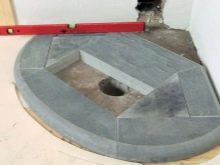

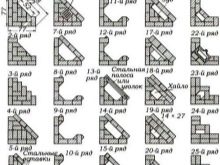
- The depth of the pit for the fireplace should be 20 cm below the soil freezing line.
- The free space between the floor of the building and the foundation is at least 5 mm. This will allow avoiding cracks, deformation of structural elements and the design of the hearth at a temperature drop. The gap is usually filled with sand.
With today's vast selection of finished products and materials for creating a fireplace with your own hands, making an old dream come true is not difficult. Models can be matched to any wallet size.
For information on how to make a brick fireplace with your own hands, see the next video.













The comment was sent successfully.